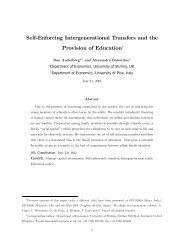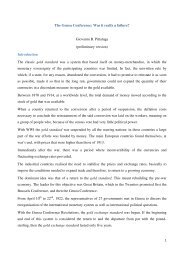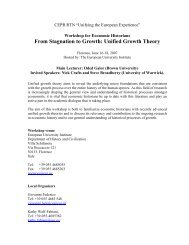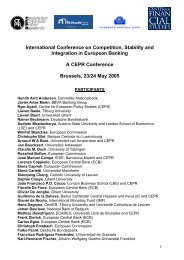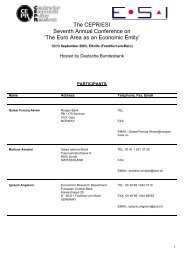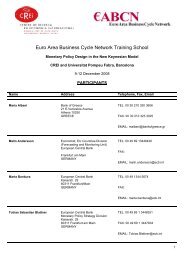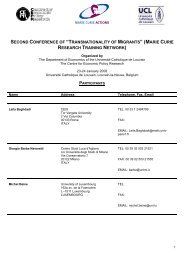MARKET STRUCTURE AND ENTRY: WHERE'S THE BEEF? - CEPR
MARKET STRUCTURE AND ENTRY: WHERE'S THE BEEF? - CEPR
MARKET STRUCTURE AND ENTRY: WHERE'S THE BEEF? - CEPR
Create successful ePaper yourself
Turn your PDF publications into a flip-book with our unique Google optimized e-Paper software.
tabulations provide the information that not all the districts in our sample appear to be<br />
viable markets. If some of our markets were truly ‘impossible’, including them in the<br />
data would bias our results. 14 Using the McD population threshold as a filter would lead<br />
us to exclude 137 district observations, whereas using BK’s threshold would exclude 262<br />
(less than or at most 10% of all observations, but roughly a quarter of new market (0,0)<br />
structure observations). We therefore explored the effects of excluding some markets<br />
from the sample on grounds of small size.<br />
4. A REDUCED FORM APPROACH<br />
4.1. The Model<br />
In this Section, we first present reduced form results, and then discuss different<br />
robustness tests based upon them. We estimate the following reduced form entry function<br />
(as suggested by Reiss, 1996; Berry, 1992):<br />
(5) Π ijt = X' ijt β i + g(<br />
n jt,<br />
m jt , θ i)<br />
+ υ ijt<br />
Subscript i denotes firm ( i ∈ { M , B}<br />
, where M stands for McD and B for BK), j market,<br />
and t the time period; the vector Xijt includes market and (possibly) firm specific<br />
variables; g(.) is a function of existing own (njt) and rival (mjt) outlets in market j (see<br />
also Mazzeo, 1999); and β i and θi are vectors of firm specific parameters to be estimated.<br />
We explore different ways of measuring market structure, two of which are: i) a count<br />
variable for the number of outlets of firm i, i = M, B; and ii) a vector that consists of<br />
indicator variables that take the value unity if the observed market structure is (njt, mjt).<br />
In addition to the usual problems with reduced form, an additional problem is that (5)<br />
does not allow a rich way to control for multi-outlet firms’ opportunity costs of not<br />
entering. In particular, it seems reasonable to assume that the profits from not having any<br />
15



